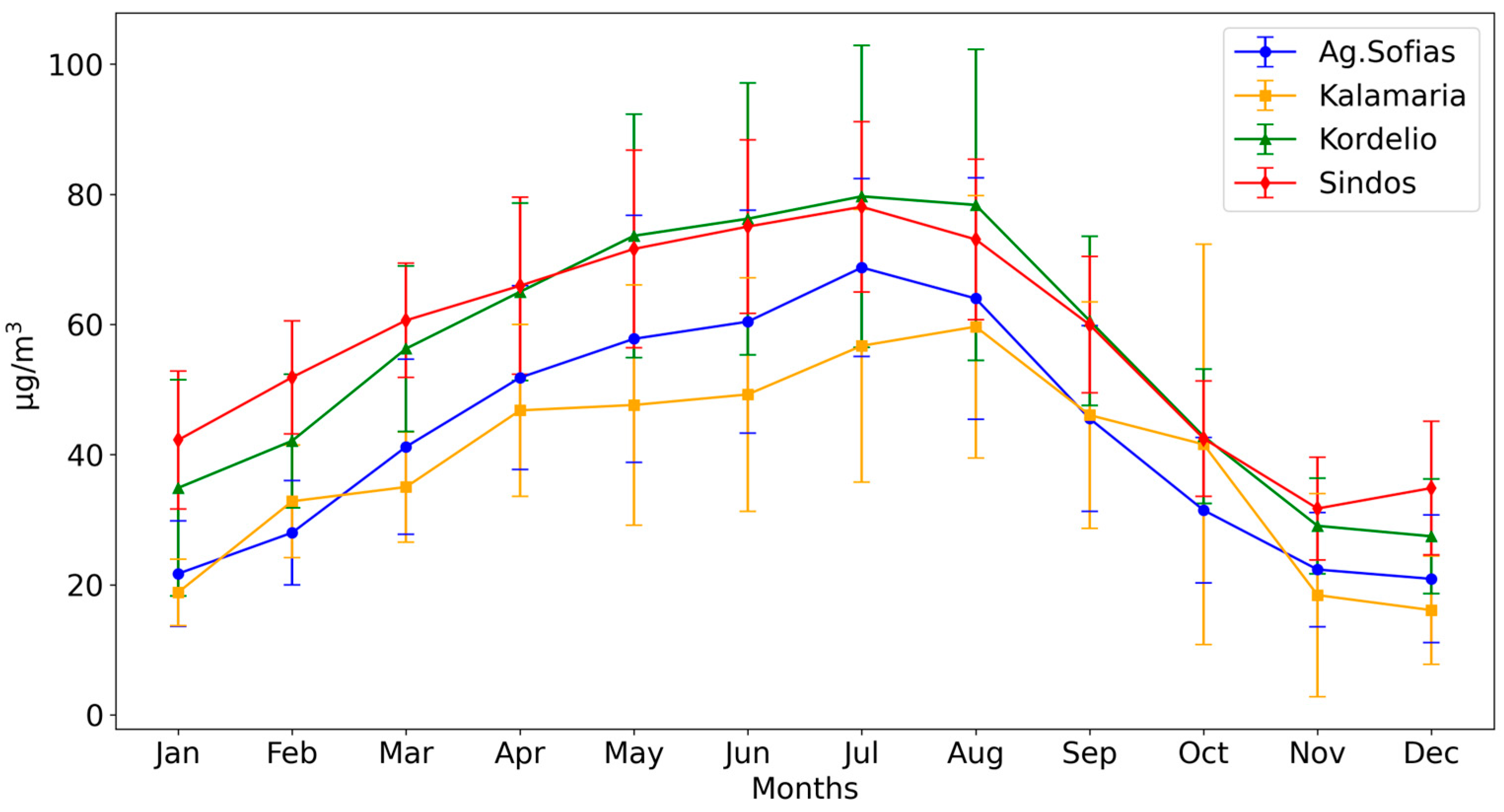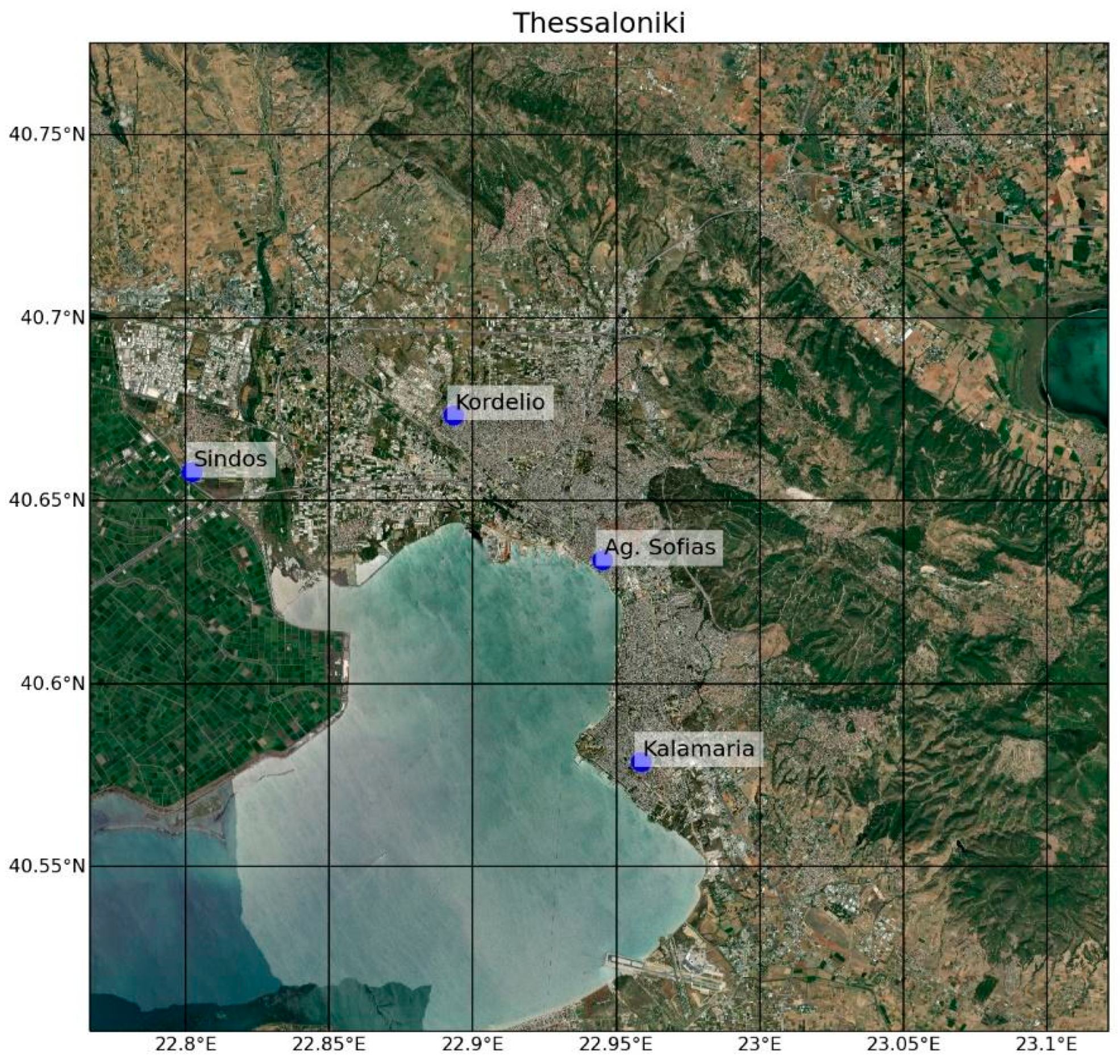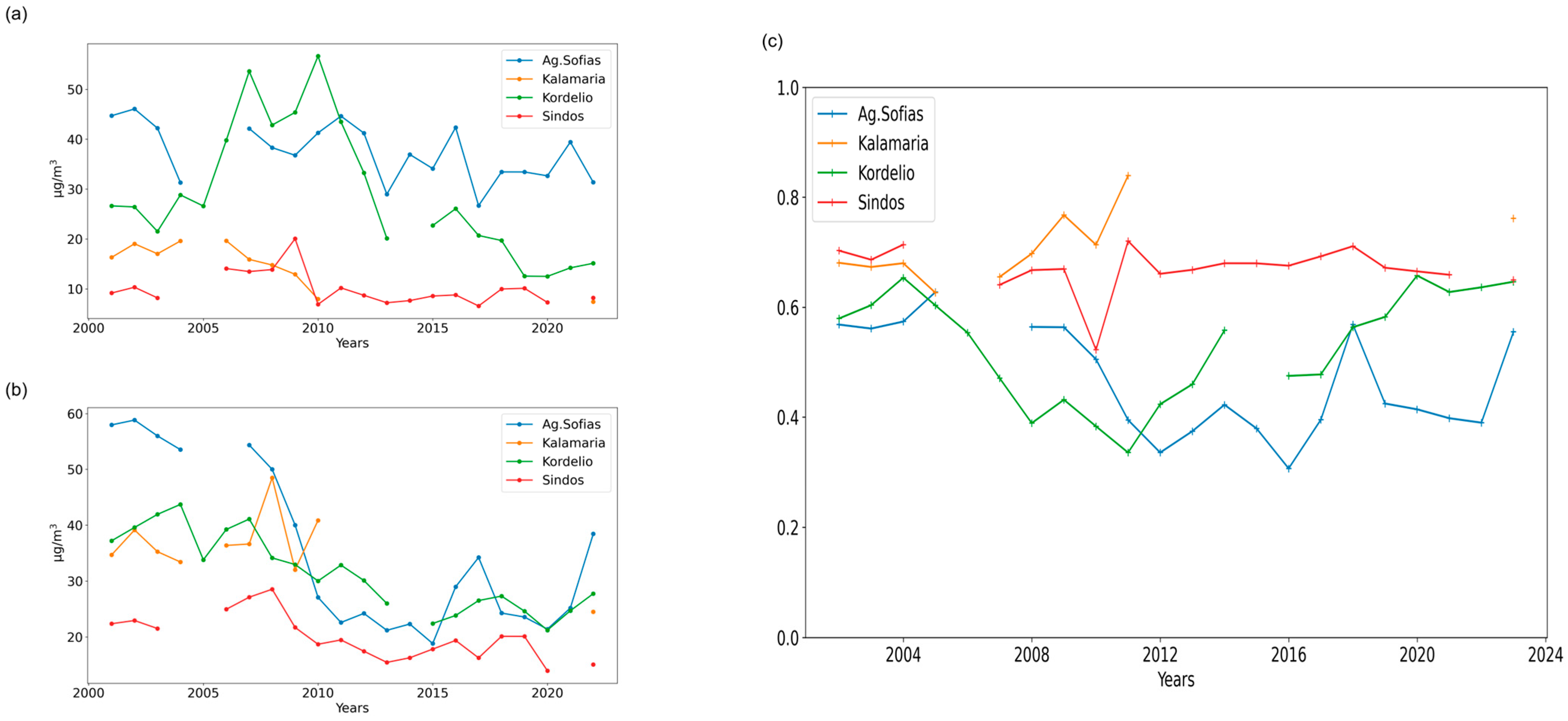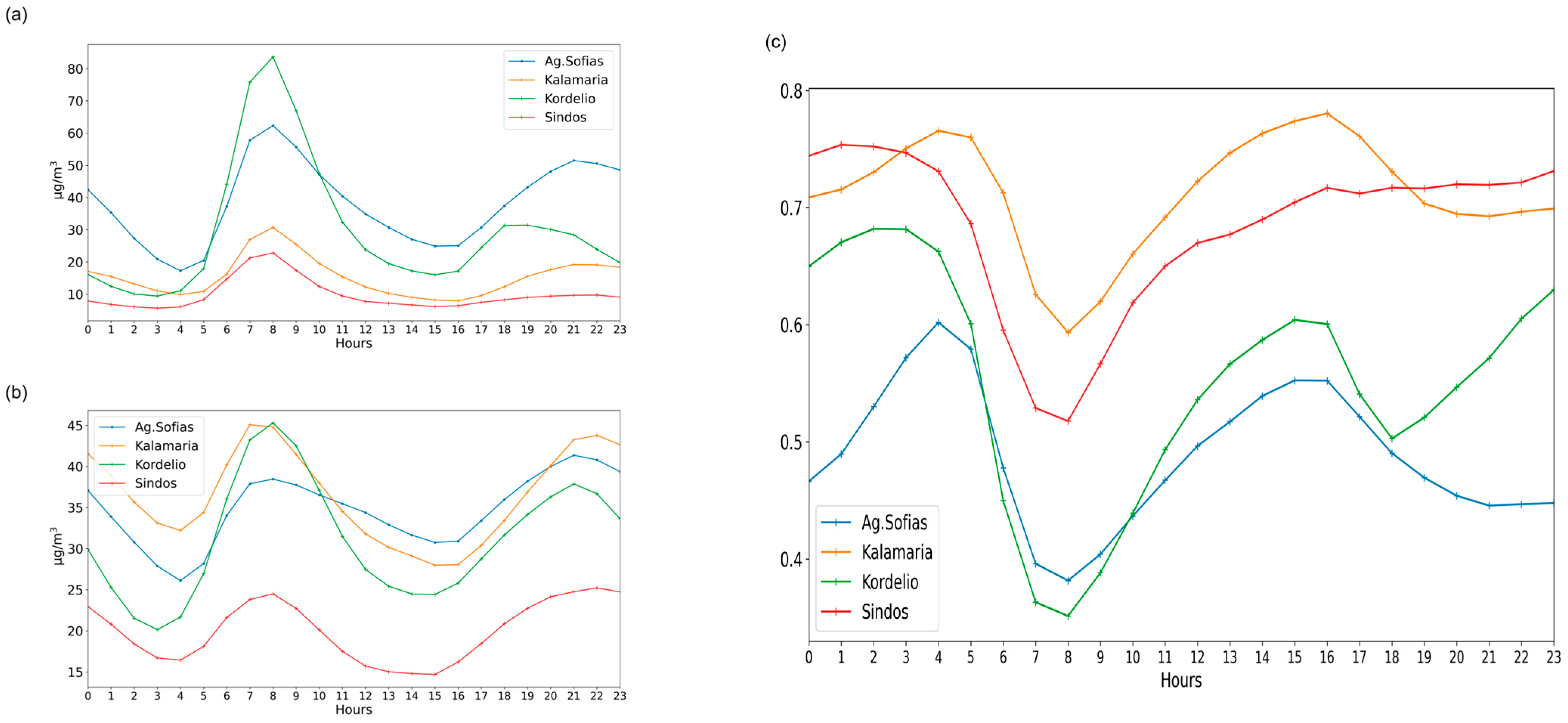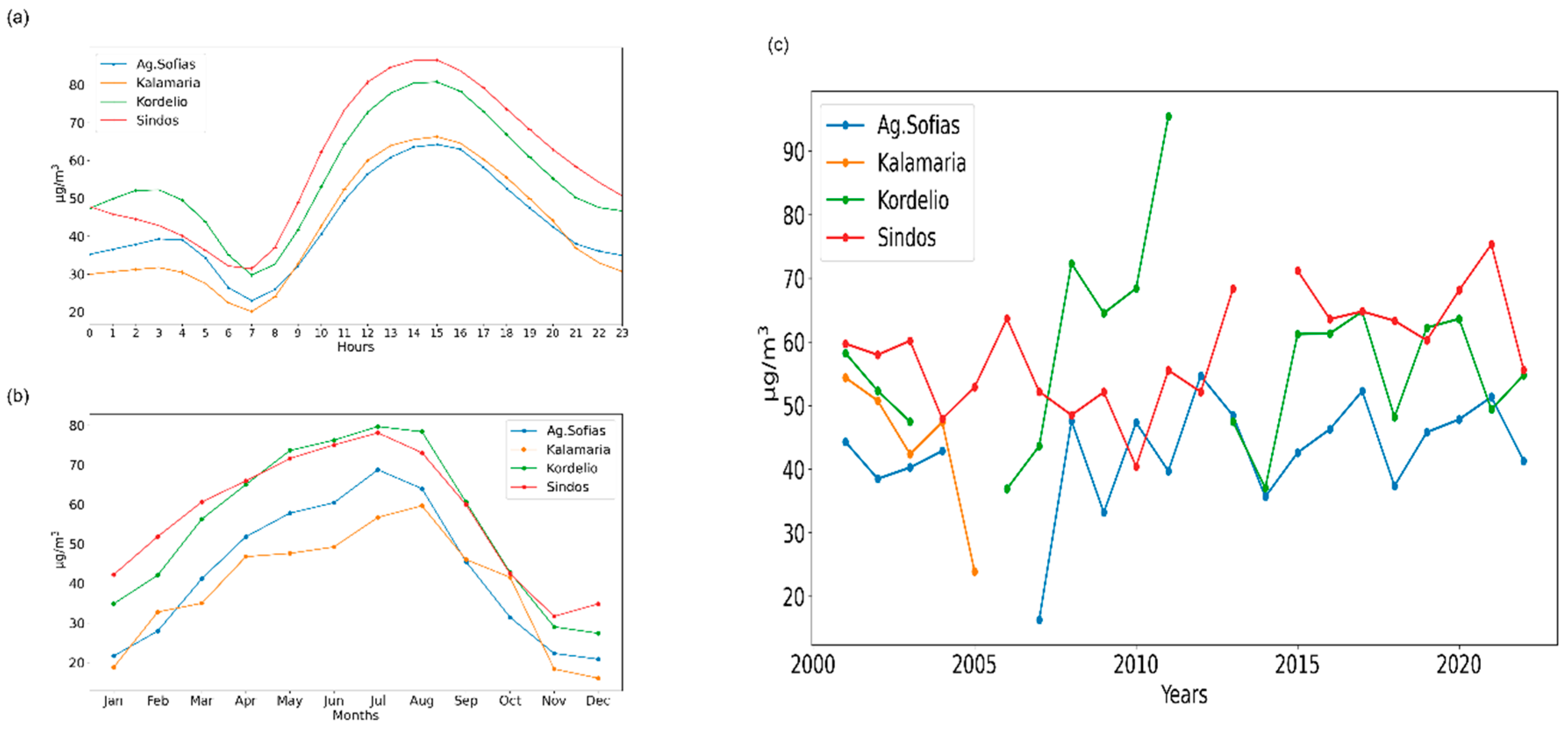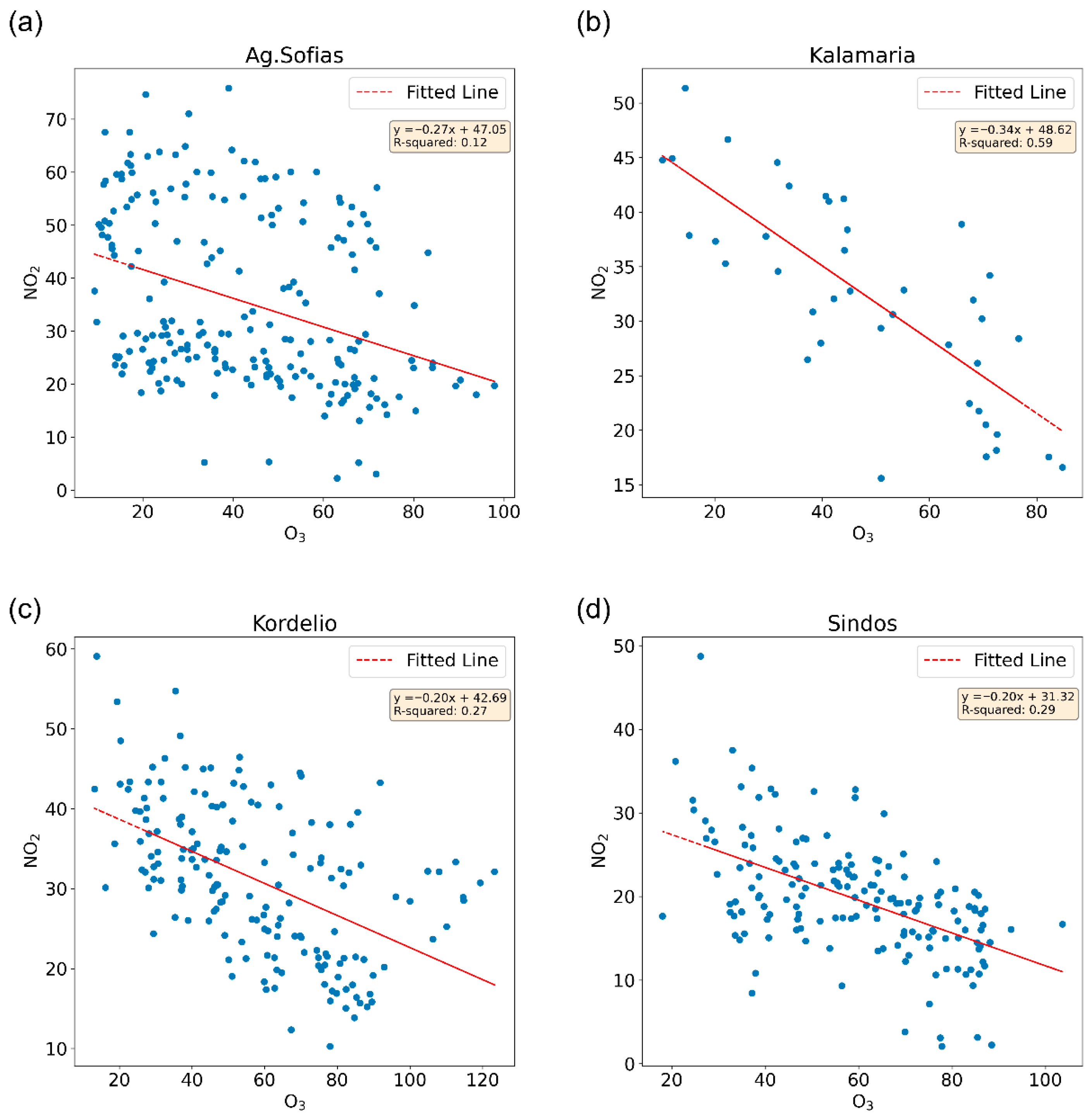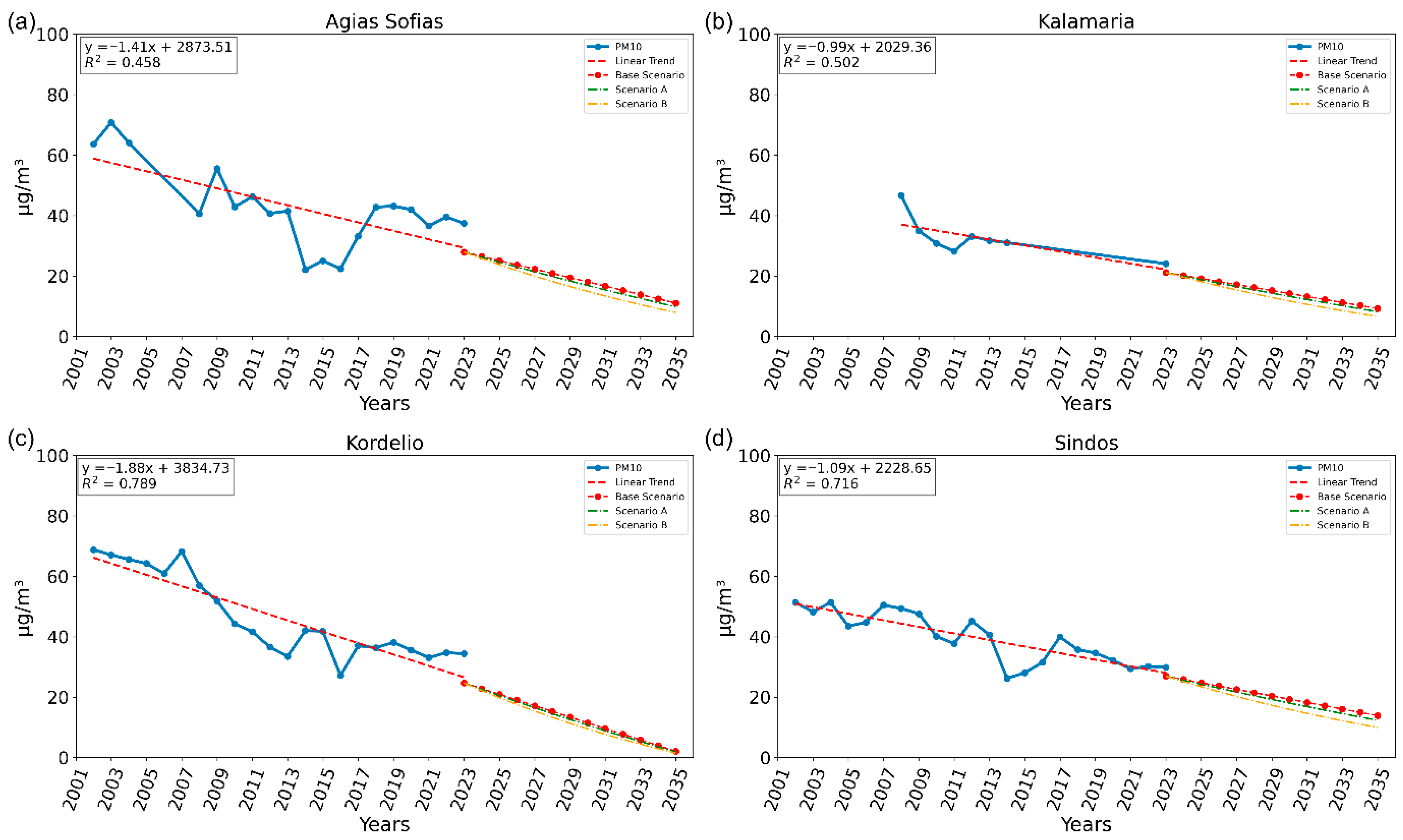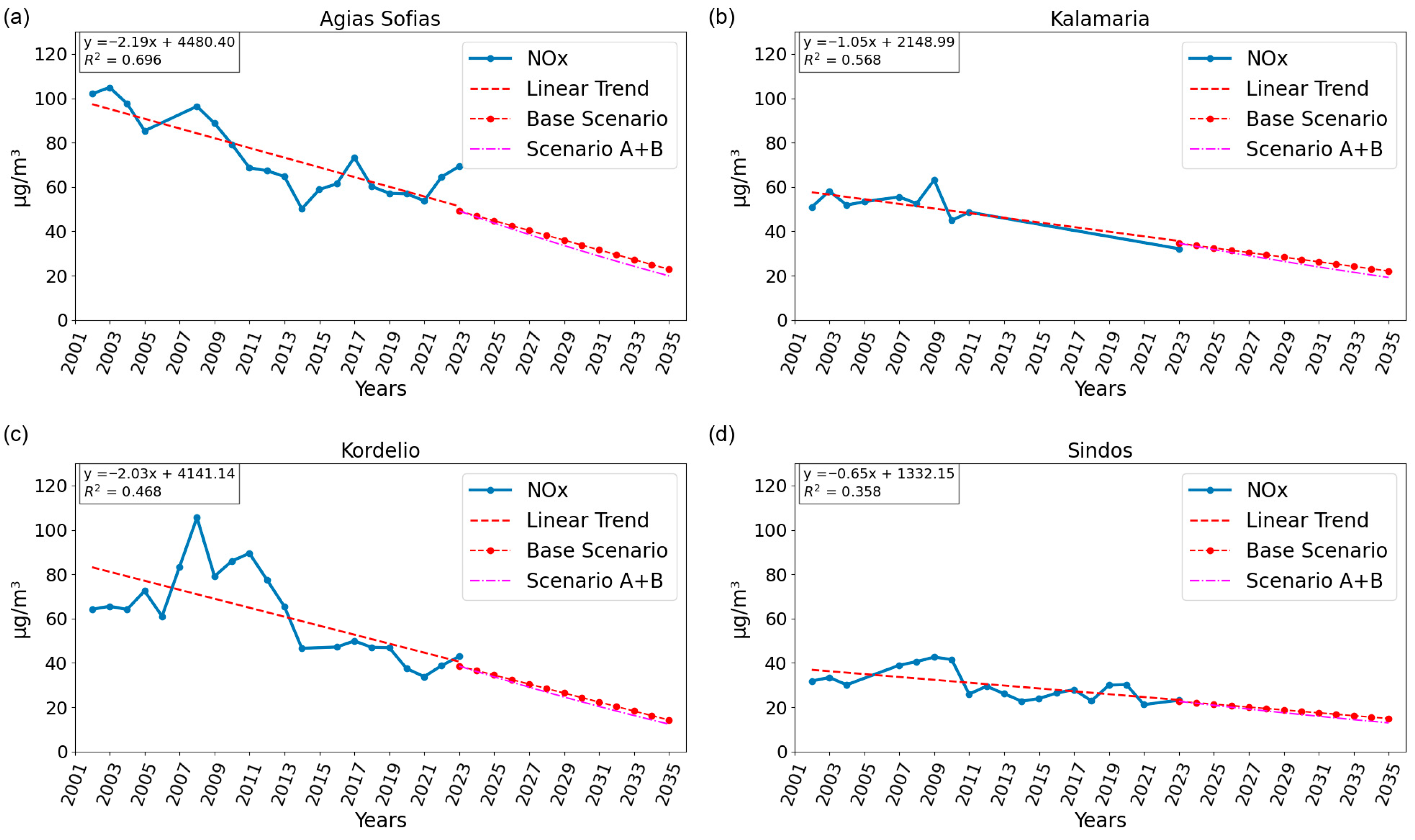The diagrams presented at this section describe the daily or monthly variability of the air pollutants, as well as their trends as annual means. In addition, the covariance of various nitrogen compounds is presented, along with the correlated variation of NO2 with O3 concentrations. Finally, the correlation between PM10 concentrations and wind is examined, as well as the annual variability of O3 with temperature.
3.1. PM10
Figure 2 presents the measurements of PM10 concentrations per station over the region of Thessaloniki. The left diagram of the Figure shows the annual mean concentrations of PM10 for the years 2001–2022, as they have been calculated from the daily mean measurements provided for the four stations. The right side illustrates the mean monthly values of the pollutant from the whole period of study.
From the diagram with the annual means, it is shown that the stations exhibit a downward trend over the years until 2015, when concentrations increase, to drop again after 2018. Notably high concentrations are recorded at Agias Sofia urban–traffic station (22.1–70.8 μg/m3) and then at Kordelio urban–industrial station (27.2–68.8 μg/m3). In certain years (i.e., 2011, 2015, 2016), Sindos suburban–industrial station records the highest concentrations, probably due to the low concentrations recorded at the other stations coupled with increased industrial activity at Sindos industrial area. Kalamaria urban–background station records low concentrations ranging from 24.04 μg/m3 to 46.64 μg/m3 for the years with available data.
The diagram with the monthly variability of PM10 concentrations (
Figure 2b) depicts that the highest PM10 concentrations are observed in the colder months of the year, with the maximum observed in November. The standard deviation of these averaged values is higher in stations with higher concentrations such as Agias Sofias and Kordelio, while the values are more enhanced during October and November, where concentrations are also higher (see also
Table A2 and
Figure A1 in
Appendix A). According to other studies, this seasonal variability is typical for the region (e.g., [
40]) and for other sites of Greece as well (e.g., [
41]). This increase in PM10 during the colder months is linked with the emissions from domestic heating, which are one of the main contributors of PM10 [
42], coupled with increased traffic and adverse meteorological conditions. In addition, the financial crisis (especially during the period 2009–2018), led many households to burn lower-quality wooden material, a practice that led to increased pollutant emissions, including PM10 particles [
32,
43].
While PM10 concentrations of Kordelio and Sindos stations are mainly attributed to industrial activities and household heating, the concentrations of Agias Sofia station primarily originate from vehicle emissions. Around 2015, the adoption of petrol cars increased rapidly, and from that year onward, the concentrations recorded at Agias Sofias station also increased [
44], while after 2018 they started decreasing, probably due to measures taken coupled with the COVID-19 pandemic.
3.2. NOx
In
Figure 3, the annual mean time-series of NO and NO
2 for the period 2001–2022 are presented, as well as the time-series of the NO
2/NO
x ratio. The stations with the highest NO concentrations are Kordelio and Agias Sofias stations. Kordelio station has the highest concentrations during 2006–2010, while from 2011 to 2022, the highest concentrations are observed only in Agias Sofias station (26.7–46 μg/m
3). A significant role in this shift was played also by the allowance of diesel cars in Thessaloniki and Athens in November 2011, which are responsible for the enhanced release of NO. The next station in NO concentration levels is Kalamaria (7.4–19.7 μg/m
3), while the lowest NO concentrations are recorded in Sindos station (ranging from 6.6 μg/m
3 to 13.9 μg/m
3). The emissions of NO are mainly attributed to the transport sector. The first three stations are urban stations, with high traffic emissions, and consequently the concentrations they record are proportional to the vehicle circulation in the vicinity of each station.
The bottom left diagram of
Figure 3 shows the NO
2 concentrations. Similarly to NO, the highest concentrations have been measured in Agias Sofias station, ranging from 53.5 to 58.8 μg/m
3. The concentrations in Kordelio station range from 37.2 to 43.7 μg/m
3, while the lowest concentrations have been recorded in Sindos station (21.5–22.9 μg/m
3).
Finally, the right side of
Figure 3 exhibits the time-series of NO
2/NO
x ratio. For the years with available data, the highest values are spotted in the urban–background station of Kalamaria, reaching up to 0.84 in 2011. The lowest values are observed in Kordelio and Agias Sofias stations, with averages from all years of 0.52 and 0.47, respectively. In Agias Sofias station, the ratio decreases, compatible with an NO
2 decrease up to 2016, while afterwards it increases, showing that NO
2 decreases but at a smaller rate than NO
x. The increase is comparable with other studies performed for other regions of Greece (e.g., [
14,
15]), which showed that the highest ratio is observed in urban–background stations, and stations with high traffic have the lowest values due to the direct emission of NO by vehicles. At roadside traffic stations, the yearly average concentrations of NO
2 tend to be lower than at background locations for the same NO
x levels. This is primarily because NO has less time to oxidize into NO
2 near the road and O
3 levels are typically lower in those environments [
14]. At the suburban–industrial station of Sindos, the NO
2/NO
x ratio has shown a slight but consistent decline since 2011. Given that O
3 concentrations in the area remain relatively high, providing favorable conditions for the oxidation of NO to NO
2, the decreasing ratio suggests an increase in primary NO emissions, likely from traffic or industrial activities. This also implies that NO is entering the atmosphere at a rate that exceeds the capacity of available O
3 to convert it fully into NO
2, resulting in a lower proportion of NO
2 within total NO
x.
Figure 4 presents the diurnal concentrations for NO
x: on the left side NO and NO
2 concentrations and on the right side the NO
2/NO
x ratio. The diagrams were created based on the available data (see also
Table A1 in
Appendix A), so not all stations have the same number of years considered for the annual mean concentrations, which may introduce some uncertainties in the trends. Both pollutants exhibit similar diurnal variability. The first peak is observed in the morning at around 7–8 am, and afterwards the concentrations decrease. The morning peak is linked with emissions from vehicle exhausts during the rush hours, due to transport to work [
15]. During the day, NO
2 is photolyzed as the radiation increases, and as a result their concentrations are decreasing. From the late afternoon (at around 4 pm), concentration starts rising again mainly attributed to vehicle emissions, which are increasing when people are returning home after working hours. In addition, and as NO
x are photochemically active compounds, the absence of high levels of solar radiation favors the increase in nitrogen compounds which are not involved into O
3 formation.
In the case of NO diurnal variability, there are some discrepancies between different stations concerning the time of the second peak. More specifically, Kordelio station has the second peak at around 6 pm, while the other three stations have the second maximum of the day at around 9 pm. The earlier occurrence of the second peak at Kordelio station, relative to the later peaks observed at Agias Sofias, Kalamaria, and Sindos, may reflect a complex interplay of factors including variations in industrial work schedules, distinct commuting patterns, localized lifestyle rhythms, and potentially differing public transport services. It is worth mentioning that Sindos station has a very low second peak, slightly larger than the afternoon concentrations of the station. This possibly occurs because Sindos is a suburban–industrial station, with lower traffic emissions in comparison to the other stations. Furthermore, as Sindos is an industrial region, emissions from industrialization rise more during the day and less in the evening. Overall, in the stations with less traffic, i.e., Sindos and Kalamaria, concentrations have smaller diurnal variability than in the case of the other two stations, i.e., Agias Sofias and Kordelio, where the traffic is higher resulting in increased vehicle emissions. The findings of the present study are compatible with the findings of Anttila et al. [
45], who found that the morning and evening peaks of NO
x are associated with the traffic exhaust emissions.
Finally, regarding the ratio of NO
2/NO
x according to
Table 4, Kalamaria station has the highest values, while the lowest have been measured in Agias Sofias station and Kordelio station. The low values of the ratio are linked with the direct emissions of NO from vehicle exhausts or from industrial activities (in Kordelio station) which results in higher NO peaks, also since NO has not oxidized yet to NO
2, while the higher the values, the greater the distance from the sources [
14]. Chouloulakou et al. [
46] have developed a criterion for the characterization of the stations based on the annual mean concentrations of NO and NO
2. The table below presents the mean NO
2/NO
x ratios for the four stations. Our findings are in agreement with those of Mavroidis et al. [
14] on the ratios that correspond to different types of stations, with the highest ratio observed at Kalamaria (0.71), an urban background station, showing very similar values for such stations in both studies. The lowest ratio (0.47) was found at the Agias Sofias station, which is also close to the value reported by Mavroidis et al. [
14] for an urban traffic station in Athens (0.44).
3.3. O3
Figure 5 exhibits the ozone trends as annual mean time-series, as well as their monthly and diurnal variability. Focusing on the trends of O
3 from the annual mean time-series, the stations with the highest concentrations are Kordelio and Sindos stations. In 2008–2011, Kordelio had surprisingly increased concentrations, while afterwards they reduced to the values in line with the previous levels at this station. During this period, there was also a rise in NO concentrations, while NO
2 remained stable. This may indicate that less O
3 was being removed through chemical reactions with NO. As a result, more O
3 could accumulate in the area. In general, O
3 has steady trends without a clear tendency to increase or decrease throughout the years.
Concerning the monthly variability of O
3, the maximum concentrations are observed during the hotter months of the year, i.e., July to August, exhibiting higher standard deviations as well (see also
Table A3 and
Figure A2 in
Appendix A). Due to the photochemical character of O
3, the production of O
3 is enhanced under higher solar radiation levels, explaining the higher O
3 levels during the hotter (and sunnier) months.
Regarding interstation variability, the stations of Kordelio and Sindos are industrial and urban–suburban stations. O3 in the troposphere is produced through photochemical reactions between NOx and VOCs. VOCs also have natural sources of origin, and in suburban and industrial areas VOC concentrations may be higher. Therefore, Sindos station, which is outside the city, has the highest percentage of natural emissions of VOCs compared to the rest of the stations under study and, by extension, their presence contributes to the formation of O3.
Finally, concerning the diurnal variability of O3, the diagram shows that the higher concentrations are observed during early afternoon. Since the production of O3 is favored by the presence of NOx, which reach their maxima in the morning, and by solar radiation, the gradual production of O3 starts after the morning traffic peak and the O3 concentrations increase; as a result, the maximum O3 concentrations are observed in all stations in the early afternoon (1–2 pm), while later the concentrations start falling.
3.5. The Impact of Meteorological Parameters on Concentration of Pollutants: The Case of 2022
In this section, the relation between air pollution data and meteorological parameters is examined. The effect of wind on PM10 concentrations is shown in
Figure 7 and the effect of temperature on O
3 concentrations in
Figure 8. The year of study was 2022, since it is a very recent year with very good data availability. As no severe events occurred this year, it may be considered as representative of the conditions in Thessaloniki.
Figure 7 shows the daily mean concentrations of PM10 and the corresponding daily mean wind speed and direction for the four stations under study. Concerning the Agias Sofias station located in the city center, the maximum concentrations of PM10 are observed in the south-southeast direction, and secondly in north-northeast direction. In these two directions wind speed is relatively low (up to 10 km/h). The highest PM10 concentrations (up to 50 μg/m
3) are observed for wind speeds which do not exceed 5 km/h. In higher wind speeds, as those observed for the south-southwest wind direction, the concentrations of PM10 are low (<20 μg/m
3).
At Kalamaria station, the wind directions for which the highest speeds are observed are North-Northeast and West-Southwest. Kalamaria area is in the eastern part of Thessaloniki and is influenced by the Thermaikos Gulf; therefore, the sea and land breeze are dominant meteorological features. The maximum PM10 concentrations (around 75 μg/m3) are observed for the south-southwest direction for which moderate wind speeds prevail, which do not exceed 2 km/h. In general, Kalamaria is the area with the lowest wind speeds as compared to the other three stations.
Concerning the Kordelio area, the highest wind speeds (around 18 km/h) are observed for northeast winds, which are associated with low PM10 concentrations. The highest PM10 concentrations are depicted in winds of lower velocities, which are coming from all the directions. Finally, in Sindos the highest wind speeds are observed for northeast, east and south-southwest wind directions. In the case of northeastern winds, the concentrations are relatively low for wind speeds greater than 10 km/h, while the other two wind directions are characterized by higher PM10 concentrations (around 65 μg/m3). Lower wind speeds result in increased PM10 concentrations since the pollutants are not transported further outside the city. However, PM10 concentrations do not exceed 75 μg/m3.
These findings showcase the inverse relationship between wind speed and PM10 concentrations, since increased wind speeds are associated with lower PM10 levels, while the highest concentrations are observed when wind speeds fall below 5 km/h. The enhanced PM10 concentrations observed for southern winds, as well as for southeastern and southwestern winds, are associated also with the presence of the sea in the south and of mountains on the north. PM10 particles are also originating from the port in the south/southwestern part of the city, but also from other sources in Thessaloniki, including domestic heating and transport emissions. Local emissions of PM10 from industrial activities in the western part of the city are recirculated over the area of Thessaloniki with the aid of the sea breeze during the day, which comes from the southwest and southeast thought the year, transferring them over the terrestrial territories of central Macedonia. During the night, the land breeze is favored and the pollutants are transported toward the sea.
In addition to studying the relationship between wind and PM10, the covariance between O
3 concentrations and temperature was also investigated.
Figure 8 shows the annual variability of O
3 and temperature as monthly mean values for the city center and the Sindos area. Overall, the trends were similar across all four stations; however, for brevity, results are presented here only for the urban and industrial stations.
Both temperature values and O3 concentrations rise as the seasons change from winter to summer, exhibiting a seasonal pattern. The maximum O3 concentrations are observed in April, when increased solar radiation favors O3 production reactions involving volatile organic compounds and NOx, while traffic is not reduced yet as in the summer months. The O3 concentrations remain high until July, when they start dropping, initially due to the summer holiday period of August and then due to the decreased solar radiation in autumn and winter.
The levels of O
3 and temperature demonstrate an overall positive correlation, with the increase in O
3 concentrations starting a bit earlier in the year than the increase in temperatures. In Mediterranean coastal regions such as the Thessaloniki area, which are characterized by high levels of solar radiation throughout the year—particularly during the summer months—such co-variability between temperature and O
3 concentrations is expected and well-documented [
46,
47].

